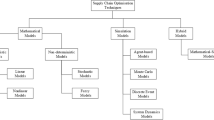Abstract
Current methods of technology assessment seldom include the manufacturing processes and organization around the investment target. As most interdependencies cannot be quantified, companies predominantly assess technology investments via methods which exclude monetary evaluation of technological aspects. Moreover, future costs and benefits of the manufacturing technologies are rarely considered systematically when making conventional investment decisions. This procedure does not necessarily lead to an optimal investment choice. In order to invest in low life-cycle costs technologies, the costs within the manufacturing processes and organization around the investment target, as well as all future costs and benefits, have to be carefully considered. The following paper introduces a new approach to analysing Total Costs and Benefits of Ownership (TCBO) using process chain simulation models. A representative manufacturing concept provides a practical insight how to use simulation in order to generate a database for technology assessment. Furthermore, the article discusses how future costs and benefits as well as the Net Present Value method, could be integrated within the TCBO-approach.






Similar content being viewed by others
References
Gerybadze A (1996) Technologische Vorhersagen. In: Kern W, Schröder H-H, Weber J (eds) Handwörterbuch der Produktionswirtschaft. Schäffer-Poeschel, Stuttgart
Baldwin J, Scott J (1987) Market structure and technological change. Harwood Academic Publishers, London
Barro RJ, Sala-i-Martin X (1995) Economic growth. MIT Press, New York
Segerstrom PS (1991) Innovation, imitation, and economic growth. J Polit Econ 99(4):807–827
Ford D, Ryan C (1981) Taking technology to market. Harv Bus Rev 2:117–126
Ansoff HI (1984) Implanting strategic management. Prentice-Hall, Englewood Cliffs, New Jersey
Christensen CM (1999) Innovation and the general manager. Irwin/McGraw Hill, Boston, Mass
Cioffi DF (2005) A tool for managing projects: an analytic parameterization of the S-curve. Int J Project Manag 23:215–222
Maidique MA, Patch P (1982) Corporate strategy and technological policy. In: Tushman ML, Moore WL (eds) Readings in the management of innovation. Cambridge University Press, Cambridge, Mass, pp 273–285
Tanaka M (1989) Cost planning and control systems in the design phase of a new product. In: Monden Y, Sakurai M (eds) Japanese management accounting. A world class approach to profit management. Productivity press, Cambridge, Massachusetts, pp 49–71
Lowe P (1995) The management of technology. Chapman & Hall, London
Dickinson MW, Thornton AC, Graves S (2001) Technology portfolio management: optimizing interdependent project over multiple time periods. IEEE Trans Eng manag 58(4):518–524
Yu OS (2006) Technology portfolio planning and management—practical concept and tools. Springer, New York
Westkämper E (2007) Strategic development of factories under the influence of emergent technologies. CIRP Ann Manuf Technol 56(1):419–422
Phaal R, Farrukh CJP, Probert DR (2004) Technology roadmapping—A planning framework for evolution and revolution. Technol Forecast Soc Change 71(1–2):5–25
Farrukh C, Phaal R, Probert D (2003) Technology roadmapping: linking technology resources into business planning. Int J Technol Manag 26(1):2–19
Nyhuis P, Wulf S, Klemke T (2010) Integrative factory, technology, and product planning—systemizing the information transfer on the operational level. Prod Eng Res Dev 4:231–237
Giebel M, Essmann H, Du Preez N, Jochen R (2009) Improved innovation through the integration of Quality Gates into the Enterprise and Product Lifecycle Roadmaps. CIRP J Manuf Sci Technol 1(3):100–205
Grienitz V (2004) Technologieszenarien: Eine Methodik zur Erstellung von Technologieszenarien für die strategische Technologieplanung, HNI-Verlagsschriftenreihe 151, Phd thesis, Universität Paderborn
Zinser S (2000) Eine Vorgehensweise zur szenariobasierten Frühnavigation im strategischen Technologiemanagement, IPA-IAO-Forschung und-Praxis 323, Phd thesis, Universität Stuttgart
Schäfer H (2005) Unternehmensinvestition–Grund-züge in Theorie und Management, 2. Auflage. Pysica-Verlag, Heidelberg
Götze U (2006) Investitionsrechnung–Modelle und Analysen zur Beurteilung von Investitions-vorhaben, 5. Auflage. Springer, Berlin
Ashford RW, Dyson RG, Hodges SD (1988) The capital-investment appraisal of new technology: problems, misconceptions and research directions. J Oper Res Soc 39(7):637–642
Dore MHI (1977) Dynamic investment planning. Croom Helm Ltd, London
Olmsted Teisberg E (1995) Methods of evaluating capital investments decisions under uncertainty. In: Trigeorgis L (ed) Real options in capital investments: models, strategies and applications. Praeger Publishers, Westport, pp 31–47
Levitt T (1965) Exploit the product life cycle. Harv Bus Rev November–December, pp 81–94
Ellram LM (1993) A framework for total cost of ownership. Int J Logist Manag 4:49–60
Weyrauch J (2002) Optimierung der Lebenszykluskosten im Anlagenbau, Phd thesis, Universität Magdeburg
Janz D, Sihn W (2005) Product redesign using value-oriented life cycle costing. CIRP Ann Manuf Technol 54(1):9–12
Niemann J, Westkämper E (2005) Product life cycle management in the digital age. In: Leondes CT (ed) Intelligent knowledge-based systema, vol II. World Scientific Publishing, London, pp 677–707
Denkena B, Henning H, Lorenzen L-E (2010) Genetics and intelligence: new approaches in production engineering. Prod Eng 4(1):65–73
VDI 2884 (2005) Purchase, operating and maintenance of product equipment using Life Cycle Costing (LCC). Verein Deutscher Ingenieure (VDI), Düsseldorf
VDMA-Einheitsblatt 66412-1 (2009) Manufacturing execution systems (MES) Kennzahlen, Beuth
Mishan EJ, Quah E (2007) Cost benefit analysis. Routledge, New York
Volpert V (1989) Kapitalwert und Ertragssteuer—Bedeutung der Finanzierungsprämisse in der Investitionsrechnung, Dt. Universitätsverlag, Wiesbaden
DIN EN 60300-3-3 (2005) Dependebility management—part 3.3: application guide—Life cycle costing, Berlin
Däumler K-D (2007) Grundlagen der Investitions-und Wirtschaftlichkeitsrechnung. NWB Verlag, Herne
Acknowledgments
This research work was supported by the German Research Foundation (Deutsche Forschungsgemeinschaft, DFG) within the Project "Integrated Assessing of Technologies and Manufacturing Processes” (DE 447/72-1).
Author information
Authors and Affiliations
Corresponding author
Rights and permissions
About this article
Cite this article
Denkena, B., Schürmeyer, J. & Eikötter, M. Linking total costs and benefits of ownership (TCBO) and process chain simulation for integrated assessment of manufacturing technologies and processes. Prod. Eng. Res. Devel. 5, 557–564 (2011). https://doi.org/10.1007/s11740-011-0313-2
Received:
Accepted:
Published:
Issue Date:
DOI: https://doi.org/10.1007/s11740-011-0313-2




